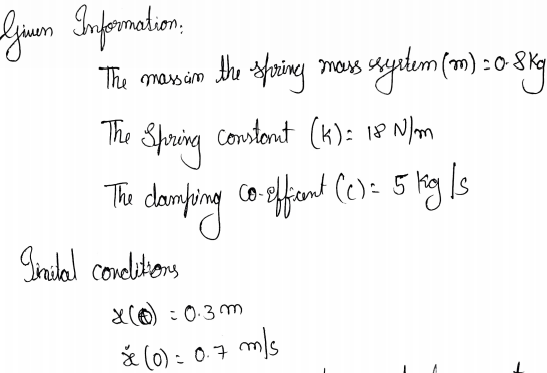Problem 2 (Estimating the Damping Constant). Recall that we can experimentally mea- sure a spring constant using Hooke's law-we measure the force F required to stretch the spring by a certain y from its natural length, and then we solve the equation F = ky for the spring constant k. Presumably we would have to determine the damping coefficient of a dashpot empirically as well, but how would we do so? As a warm-up, suppose we have a underdamped, unforced spring-mass system with mass 0.8 kg, spring constant 18 N/m, and damping coefficient 5 kg/s. We pull the mass 0.3 m from its rest position and let it go while imparting an initial velocity of 0.7 m/s. (a) Set up and solve the initial value problem for this spring-mass system. (b) Write your answer from part (a) in phase-amplitude form, i.e. as y(t) = Aet sin(ßt – 4) %3D and graph the result. Compare with a graph of your answer from (a) to check that you have the correct amplitude and phase shift. (c) Find the values of t at which y(t) attains a local maximum (there will be infinitely many, of course), and observe that the time distance between any two consecutive maxima is always the same.
Problem 2 (Estimating the Damping Constant). Recall that we can experimentally mea- sure a spring constant using Hooke's law-we measure the force F required to stretch the spring by a certain y from its natural length, and then we solve the equation F = ky for the spring constant k. Presumably we would have to determine the damping coefficient of a dashpot empirically as well, but how would we do so? As a warm-up, suppose we have a underdamped, unforced spring-mass system with mass 0.8 kg, spring constant 18 N/m, and damping coefficient 5 kg/s. We pull the mass 0.3 m from its rest position and let it go while imparting an initial velocity of 0.7 m/s. (a) Set up and solve the initial value problem for this spring-mass system. (b) Write your answer from part (a) in phase-amplitude form, i.e. as y(t) = Aet sin(ßt – 4) %3D and graph the result. Compare with a graph of your answer from (a) to check that you have the correct amplitude and phase shift. (c) Find the values of t at which y(t) attains a local maximum (there will be infinitely many, of course), and observe that the time distance between any two consecutive maxima is always the same.
Related questions
Question
Differential Equations Please answer one of the two questions please step by step.
TYPO; PART E SUPPOSED ""Suppose we keep the mass and spring constant the same as in part (a), but we do not know the damping coefficient b."

Transcribed Image Text:Problem 2 (Estimating the Damping Constant). Recall that we can experimentally mea-
sure a spring constant using Hooke's law-we measure the force F required to stretch the
spring by a certain y from its natural length, and then we solve the equation F = ky for
the spring constant k. Presumably we would have to determine the damping coefficient of
a dashpot empirically as well, but how would we do so?
As a warm-up, suppose we have a underdamped, unforced spring-mass system with mass
0.8 kg, spring constant 18 N/m, and damping coefficient 5 kg/s. We pull the mass 0.3 m
from its rest position and let it go while imparting an initial velocity of 0.7 m/s.
%3D
(a) Set up and solve the initial value problem for this spring-mass system.
(b) Write your answer from part (a) in phase-amplitude form, i.e. as
y(t) = Aeºt sin(ßt – 4)
and graph the result. Compare with a graph of your answer from (a) to check that
you have the correct amplitude and phase shift.
(c) Find the values of t at which y(t) attains a local maximum (there will be infinitely
many, of course), and observe that the time distance between any two consecutive
maxima is always the same.
(d) Compute the ratio of the displacements at two consecutive maxima. (That is, if y has
a maximum at tn, and the next one occurs at tn+1, compute y(tn)/y(tn+1).) Observe
that this ratio is constant.
(e) Everything we have done so far generalizes to all underdamped spring-mass systems,
and we can use it to estimate the damping coefficient experimentally. Suppose we
keep the mass and spring constant the same as in part (a), but we do not know the
spring constant b. Redo parts (a)-(d) (except for graphing y(t)) and express your
answer in terms of b.
(f) Suppose that after we release the mass, the first maximum displacement is 0.5 m,
and then 4 seconds later another maximum displacement of 0.2 m occurs. Use your
answer from part (e) to estimate the damping coefficient.
Expert Solution
Step 1

Step by step
Solved in 8 steps with 9 images
